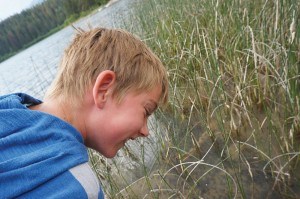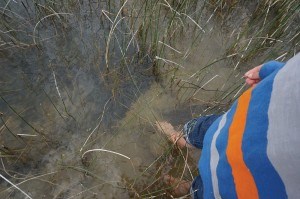

It’s been awhile since I’ve seen my son actually squeal with pure delight—but that’s what happened when hundreds of toad tadpoles tried to nibble his toes at Patricia Lake last week.
Unlike other amphibians in the park’s water bodies that disperse at this stage, these future toads huddle in great, amoeboid black masses by the thousands. Try as we might to give them space, there was something irresistible about my boy’s toes that kept them coming back.
I took a picture of him as the tadpoles nibbled, and I’ve been staring at it all week. It’s there in his face—the magic is happening. Every time I look at it I feel fortunate to live in a place where he can get his feet wet and hands dirty, a connection that we now know is so critical to healthy development in children.
Throughout history, humans have had an intimate relationship with nature. It should come as no surprise, then, that our well-being—and of our children’s—is tied to everything from the dirt in our gardens, to the dust (and who knows what else) our pets drag into our living rooms.

There is mounting scientific evidence that interaction with nature delivers a range of measurable positive impacts to human physical health, psychological well-being, cognitive ability, and social cohesion. For those who share the privilege of living here, it’s almost too obvious to point out. Still, it’s fun to think about exactly what’s at work.
It’s become difficult to convince a portion of our society that a dirty kid is a good thing. But it turns out that grimy is the way to go, at least to a certain extent.
For almost a decade, scientists have suspected that certain soil bacteria activate our brain cells to produce the chemical serotonin. Serotonin is busy in our bodies—thought to be involved in constricting smooth muscles, transmitting impulses between nerve cells, and regulating moods that contribute to well-being and happiness.
Think of dirt as a kind of antidepressant.
As a matter of fact, think of those little dirt bacteria as tiny members of the army of microbes that interface with our lungs, skin and guts, improving our immunity and general well-being.
Sanitizing our kids denies them access to the microbes that help build their body’s defenses. Dirt under the fingernails, snuggling a mucky pet, and a little puddle-hopping, does more good than harm for most kids.
Outdoor play is of course so much more than microbes. The ways in which nature is important to childhood development are piling up like kids on a bag of chips. For example, the non-organized, stick-and-rock-type of free play is critical to the brain’s ability to develop executive functioning—a child’s ability to set their own goals and take actions to meet those goals without prodding from adults.
This might be one of the most important skill sets they get. One study suggested that it helps in many aspects of their daily lives, from “flexibly switching between different activities rather than getting stuck on one thing, to stopping themselves from yelling when angry, to delaying gratification. Executive function during childhood also predicts important outcomes, like academic performance, health, wealth and criminality, years and even decades later,” said study author Yuko Munakata, in a press release.
If that isn’t convincing enough, there is evidence to suggest that when children spend time in nature or urban green spaces, it can reduce stress, obesity, and even reduce the prevalence of behaviours associated with attention deficit disorders.
Scientists are still learning about these benefits, but early work is promising.
The benefits of wild spaces to children (and all humans) are too countless to include here, and, as I say to my 10-year-old, it’s not all about us. Interaction with nature is good for nature, too.
Early encounters with the big wild—that frog you carried around in a bucket, that worm you dug out of the garden—build connections with the land that last a lifetime. Early connections may be one of the greatest predictors of whether or not a child will grow up to care for nature as an adult—and goodness knows, nature could certainly use admirers as we hurtle toward eight billion people on the planet.
As I stared at the picture of my son with his toes under tadpole siege, I realized something else this week: for about half an hour, we were both on tadpole time—completely immersed in this little miracle (or thousands of little miracles).
It’s rare that I feel that fully present, and it reminded me of being a kid myself, when my mind wasn’t racing toward the next thing on my to-do list, fingers scratching at my iPhone.
It was a nice mental vacation from the spinning, digital world that pulls on me, threatening to encroach if I don’t make more time for the important things—for starters, dirty hands and wet feet.
Niki Wilson
Special to the Fitzhugh
